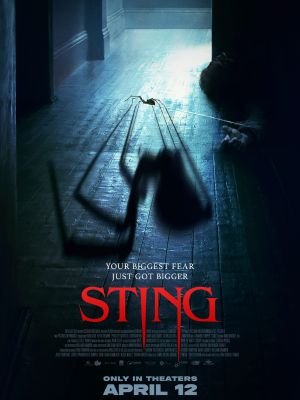
“Sting” is a modestly scaled horror caper which pitches a flesh-eating spider against a handful of Brooklynites, but ninety one minutes (including seven for closing credits) aren’t enough. Nevertheless, some additional minutes would have gone a long way in view of how rushed and underdeveloped many characters and animal attack scenes are in this glossy genre exercise. Granted, puffing up a b-movie like this can only do so much good; however, an extra 15-20 minutes could hardly have hurt this Spielberg-y creature feature with creature effects by Wētā Workshop (“Lord of the Rings” trilogy).Writer/director Kiah Roache-Turner (“Wyrmwood: Road of the Dead”) and his team behind “Sting” have seen quite a few genre films yes; although they never result into good cheap thrills or crowd-pleasing adventure drama.
Like most post-Amblin entertainments, “Sting” is about nuclear family discord with occasional breaks to become another Animals Attack movie. Ethan (Ryan Corr), a typical “post-Spielberg dad”, has a fatal flaw—wearing too many hats and that’s it. He superintends an apartment building in Brooklyn owned by Gunter (Robyn Nevin), the meanest slum-lady ever created for film. Additionally, Ethan is an aspiring comic book artist.
Ethan’s daughter Heather (Penelope Mitchell) inspires his comics since she is portrayed as the angsty pre-teen Charlotte (Alyla Brown). While trying to play his dual role as breadwinner and working stiff, Ethan actually cares but remains insecure. Even seemingly manageable issues tend to get out of hand very quickly such as Gunter’s building having some mysterious pest issue or when rift widens between Ethan and Charlotte. Not even Frank (Jermaine Fowler), an aggrieved wisecracking exterminator, can help alleviate Ethan’s burden. The most sympathetic character in “Sting,” Charlotte is the one who is probably the most defined by dramatic/situational peril.
But you don’t really have to like Charlotte to care about scenes of her first raising and then chasing Sting, a pet spider that crashes on Earth in a ping-pong-ball-sized asteroid. This makes Sting larger throughout the movie but it never really develops beyond being a generic menace in “Sting.” For example, Charlotte may well have been infatuated with and then repulsed by an irradiated field mouse or perhaps even man-eating toilet ‘gator. It’s strange that Sting is even a spider since there is so much time spent by Charlotte and others navigating Gunter’s building via complex networks of air vent tunnels. It might seem reasonable that a story about a stressed dad and an unappreciated daughter would deal with web-building and family life more fully; but that isn’t what happens here.
The conventional drive towards reconciliation between Ethan and Charlotte is all “Sting” can say about their relationship at large. Nonetheless, for an immense black widow spider Wētā did quite well yet its design feels like a missed opportunity here. Just black spider with small red vertical dash down its back? Really? And I mean properly executed generic threat does not necessarily spell the end of monster movies. When characters are stock types too it just gets less interesting still as these scenes aren’t long enough or paced adequately enough to be suspenseful or gory at all.
The spider webs, bodily fluids, and gore effects mostly land anyway because they don’t need much set-up or development. However, everything that requires the Spielberg touch feels light and indistinct. Even the schtickiest elements of the movie feel sketchy. Like, why isn’t there more or better material for Gunter’s forgetful sister Helga (Noni Hazelhurst), the first character in the movie to spot Charlotte’s pet? Ditto for Frank, a beleaguered side character played by a diligent performer. These characters are clearly meant to be likable, but too many scenes—and one-liners and plot points—feel careless when they should be built up to with Spielberg-ian rigor. Otherwise, why wouldn’t audience members think of other, better monster movies?
Copying Spielberg and his successors is not an automatic demerit; all however must be well read on their principles over time before condemning them altogether. “Sting” often feels like a movie made by enthusiastic but careless fans. The laugh lines—”Why didn’t you get a ****ing dog?!”—aren’t mounted with enough comic buildup or suspense. And the action scenes usually start and stop without enough grace or energy to feel momentous.
During a representatively busy but unconvincing chase, Eric wheezes as he climbs up a vertical air vent. You can imagine why Dad’s out of breath, but there’s insufficient proof of his efforts on screen. We’re not given enough time to either luxuriate in dread or develop feelings for Eric and his family, making the fast scenes too slow and the slower scenes too quick. “Sting” has a lot of the right ideas but not enough inspiration to string them all together.
Also, Read On Fmovies
